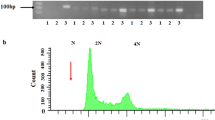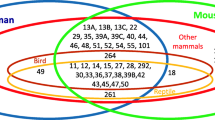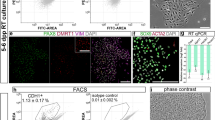Abstract
Background
Spermatogenesis is a tightly organized process that utilizes an intrinsic genetic program composed of germ cell-specific genes. Although mouse germ cell-related cell lines are available, few germ cell-specific genes have been comprehensively identified in such cell lines.
Objective
We aimed to profile gene expression in the male mouse germ cell-related cell lines, GC-1 and GC-2, characterize their transcriptomic nature, and identify potential testis- or germ cell-specific or -predominant genes expressed in these cell lines.
Methods
We performed profiling analysis of genes transcribed in the mouse germ cell-related cell lines, GC-1 and GC-2, using our previous microarray data together with public transcriptome information. We analyzed the expression of a number of the cell line genes predicted to be preferentially expressed in testis by RT-PCR.
Results
We found that most testis-specific or -predominant mRNAs are not expressed in GC-1 and GC-2 cells, implying that these cell lines have lost their testis- or germ cell-specific genetic characteristics. RT-PCR analysis of genes predicted to be expressed in the cell lines with preferential testicular expression showed the testis-specific or -predominant expression of nine genes and verified four of them as being expressed in the germ cell lines. Among them, only cyclin-dependent kinase inhibitor 3 genes (Cdkn3) showed testis and germ cell specificity.
Conclusion
Our study provides extensive transcriptomic information to shed light on the limited testicular characteristics of the mouse male germ cell-derived cell lines, GC-1 and GC-2, and offers a list of germ cell line genes with testicular preference.



Similar content being viewed by others
Data availability
The data supporting this study’s findings are available from the corresponding author upon reasonable request.
References
Baek N, Woo JM, Han C, Choi E, Park I, Kim DH, Eddy EM, Cho C (2008) Characterization of eight novel proteins with male germ cell-specific expression in mouse. Reprod Biol Endocrinol 6:32
Bellve AR, Cavicchia JC, Millette CF, O’Brien DA, Bhatnagar YM, Dym M (1977) Spermatogenic cells of the prepuberal mouse. Isolation and morphological characterization. J Cell Biol 74:68–85
Chen YC, Hsiao CD, Lin WD, Hu CM, Hwang PP, Ho JM (2006) ZooDDD: a cross-species database for digital differential display analysis. Bioinformatics 22:2180–2182
Choi E, Lee J, Oh J, Park I, Han C, Yi C, Kim DH, Cho BN, Eddy EM, Cho C (2007) Integrative characterization of germ cell-specific genes from mouse spermatocyte UniGene library. BMC Genomics 8:256
Eddy EM (1995) 'Chauvinist genes' of male germ cells: gene expression during mouse spermatogenesis. Reprod Fertil Dev 7:695–704
Eddy EM (1998) Regulation of gene expression during spermatogenesis. Semin Cell Dev Biol 9:451–457
Eddy EM (2002) Male germ cell gene expression. Recent Prog Horm Res 57:103–128
Geissler EN, Ryan MA, Housman DE (1988) The dominant-white spotting (W) locus of the mouse encodes the c-kit proto-oncogene. Cell 55:185–192
Gu Y, Rosenblatt J, Morgan DO (1992) Cell cycle regulation of CDK2 activity by phosphorylation of Thr160 and Tyr15. EMBO J 11:3995–4005
Hannon GJ, Casso D, Beach D (1994) KAP: a dual specificity phosphatase that interacts with cyclin-dependent kinases. Proc Natl Acad Sci U S A 91:1731–1735
Hofmann MC, Narisawa S, Hess RA, Millan JL (1992) Immortalization of germ cells and somatic testicular cells using the SV40 large T antigen. Exp Cell Res 201:417–435
Hofmann MC, Hess RA, Goldberg E, Millan JL (1994) Immortalized germ cells undergo meiosis in vitro. Proc Natl Acad Sci U S A 91:5533–5537
Hong S, Choi I, Woo JM, Oh J, Kim T, Choi E, Kim TW, Jung YK, Kim DH, Sun CH et al (2005) Identification and integrative analysis of 28 novel genes specifically expressed and developmentally regulated in murine spermatogenic cells. J Biol Chem 280:7685–7693
Hong SH, Kwon JT, Kim J, Jeong J, Kim J, Lee S, Cho C (2018) Profiling of testis-specific long noncoding RNAs in mice. BMC Genomics 19:539
Jan SZ, Hamer G, Repping S, de Rooij DG, van Pelt AM, Vormer TL (2012) Molecular control of rodent spermatogenesis. Biochim Biophys Acta 1822:1838–1850
Kim J, Kwon JT, Jeong J, Kim J, Hong SH, Kim J, Park ZY, Chung KH, Eddy EM, Cho C (2018) SPATC1L maintains the integrity of the sperm head-tail junction. EMBO Rep 19:e45991
Kwon JT, Ham S, Jeon S, Kim Y, Oh S, Cho C (2017) Expression of uncharacterized male germ cell-specific genes and discovery of novel sperm-tail proteins in mice. PLoS ONE 12
Nalepa G, Barnholtz-Sloan J, Enzor R, Dey D, He Y, Gehlhausen JR, Lehmann AS, Park SJ, Yang Y, Yang X et al (2013) The tumor suppressor CDKN3 controls mitosis. J Cell Biol 201:997–1012
Nozawa K, Fujihara Y, Devlin DJ, Deras RE, Kent K, Larina IV, Umezu K, Yu Z, Sutton CM, Ye Q et al (2022) The testis-specific E3 ubiquitin ligase RNF133 is required for fecundity in mice. BMC Biol 20:161
Nozawa K, Garcia TX, Kent K, Leng M, Jain A, Malovannaya A, Yuan F, Yu Z, Ikawa M, Matzuk MM (2023) Testis-specific serine kinase 3 is required for sperm morphogenesis and male fertility. Andrology 11:826–839
Poon RY, Hunter T (1995) Dephosphorylation of Cdk2 Thr160 by the cyclin-dependent kinase-interacting phosphatase KAP in the absence of cyclin. Science 270:90–93
Snyder E, Chukrallah L, Seltzer K, Goodwin L, Braun RE (2020) ADAD1 and ADAD2, testis-specific adenosine deaminase domain-containing proteins, are required for male fertility. Sci Rep 10:11536
Verma P, Parte P (2021) Revisiting the Characteristics of Testicular Germ Cell Lines GC-1(spg) and GC-2(spd)ts. Mol Biotechnol 63:941–952
Zhang R, Wu B, Liu C, Zhang Z, Wang X, Wang L, Xiao S, Chen Y, Wei H, Jiang H et al (2022) CCDC38 is required for sperm flagellum biogenesis and male fertility in mice. Development 149:dev200516
Funding
This was supported by the National Research Foundation of Korea (NRF) grant (2022R1A2C1003441), and GIST Research Institute (GRI) grant funded by GIST, Korea in 2023.
Author information
Authors and Affiliations
Contributions
C.C. conceptualized the study. S.C. S.H.H. and G.H. produced, analyzed and curated the data. S.C., S.H.H. and C.C. wrote the draft. All authors have read and agreed to the final version of the manuscript. S.C., S.H.H. and G.H. contributed equally to this work.
Corresponding author
Ethics declarations
Conflict of interest
The authors declare no conflict of interest.
Ethical approval
All animal experiments were performed in accordance with the Korean Food and Drug Administration (KFDA) guidelines. Protocols were reviewed and approved by the Institutional Animal Care and Use Committees (IACUC) of Gwangju Institute of Science and Technology (GIST) (permit number: GIST-2017-013).
Informed consent
Not applicable.
Additional information
Publisher's Note
Springer Nature remains neutral with regard to jurisdictional claims in published maps and institutional affiliations.
Supplementary Information
Below is the link to the electronic supplementary material.
13258_2023_1488_MOESM2_ESM.pdf
Supplementary file2 Supplementary Figure 2: Tissue distribution of human ortholgs of five testis-specific mouse genes (PDF 49 KB)
13258_2023_1488_MOESM3_ESM.xlsx
Supplementary file3 Supplementary Table 1: List of mRNAs expressed in testis, GC-1 cells, and GC-2 cells (XLSX 39573 KB)
13258_2023_1488_MOESM6_ESM.pdf
Supplementary file6 Supplementary Table 4: List of human orthologs and testis specificity of 25 selected testis-preferred mouse genes (PDF 187 KB)
Rights and permissions
Springer Nature or its licensor (e.g. a society or other partner) holds exclusive rights to this article under a publishing agreement with the author(s) or other rightsholder(s); author self-archiving of the accepted manuscript version of this article is solely governed by the terms of such publishing agreement and applicable law.
About this article
Cite this article
Choi, S., Hong, S.H., Han, G. et al. Profiling of testis-specific or testis-predominant genes expressed in mouse male germ cell lines GC-1 and GC-2. Genes Genom 46, 279–287 (2024). https://doi.org/10.1007/s13258-023-01488-1
Received:
Accepted:
Published:
Issue Date:
DOI: https://doi.org/10.1007/s13258-023-01488-1




